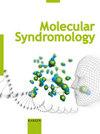女性患者的 HSD17B10 基因发生新突变并伴有畸形症状
IF 0.9
4区 医学
Q4 GENETICS & HEREDITY
引用次数: 0
摘要
简介羟基类固醇 17-beta 脱氢酶 10 型(HSD10)蛋白是一种线粒体酶。与其他线粒体疾病一样,HSD10 缺乏症也会累及多个系统。HSD10 缺乏症(疾病)非常罕见。迄今报道的病例不到 40 例。由于是 X 连锁传播,女性患者更为罕见。已报道的女性病例有 5 例。病例介绍:我们报告了一名因小头畸形和全面发育迟缓而接受检查的三岁女性患者。她有明显的畸形症状。尿液有机酸分析中检测到替格甘氨酸峰。其他代谢检查和实验室检查均无异常。脑磁共振成像显示,该患儿有轻度脑萎缩、轻度脑室扩张、胼胝体变薄以及苍白球T2信号增加。通过全外显子组测序(WES)分析发现了HSD17B10基因的杂合子新突变。我们开始限制异亮氨酸饮食,并服用线粒体维生素 "鸡尾酒"。讨论/结论:随着 WES 和基因面板的使用越来越多,我们将更频繁地见到 HSD10 疾病患者。因此,HSD10 疾病的不同发现和表型也会随之显现出来。本文章由计算机程序翻译,如有差异,请以英文原文为准。
Novel Mutation in the HSD17B10 Gene Accompanied by Dysmorphic Findings in Female Patients
Introduction: Hydroxysteroid 17-beta dehydrogenase type 10 (HSD10) protein is a mitochondrial enzyme. Multisystemic involvement occurs in HSD10 deficiency as in other mitochondrial diseases. HSD10 deficiency (disease) is rare. Less than 40 index cases have been reported so far. A female patient is even rarer because of X-linked transmission. Five index female cases have been reported. Case Presentation: We report a three-year-old female patient who was investigated due to microcephaly and global developmental delay. She had significant dysmorphic findings. The tiglylglycine peak was detected in urinary organic acid analysis. Other metabolic investigations and laboratory tests were unremarkable. Mild cerebral atrophy, mild ventricular dilation, thin corpus callosum, and an increase in T2 signal in the globus pallidus were revealed at brain magnetic resonance imaging. Heterozygous novel mutation in the HSD17B10 gene was found by whole-exome sequencing (WES) analysis. We started isoleucine-restricted diet and a “cocktail” of the mitochondrial vitamin. Discussion/Conclusion: We will see HSD10 disease patients more frequently with the increasing use of WES and genetic panels. Thus, different findings and phenotypes of the HSD10 disease will be revealed.
求助全文
通过发布文献求助,成功后即可免费获取论文全文。
去求助
来源期刊

Molecular Syndromology
Biochemistry, Genetics and Molecular Biology-Genetics
CiteScore
1.70
自引率
9.10%
发文量
67
期刊介绍:
''Molecular Syndromology'' publishes high-quality research articles, short reports and reviews on common and rare genetic syndromes, aiming to increase clinical understanding through molecular insights. Topics of particular interest are the molecular basis of genetic syndromes, genotype-phenotype correlation, natural history, strategies in disease management and novel therapeutic approaches based on molecular findings. Research on model systems is also welcome, especially when it is obviously relevant to human genetics. With high-quality reviews on current topics the journal aims to facilitate translation of research findings to a clinical setting while also stimulating further research on clinically relevant questions. The journal targets not only medical geneticists and basic biomedical researchers, but also clinicians dealing with genetic syndromes. With four Associate Editors from three continents and a broad international Editorial Board the journal welcomes submissions covering the latest research from around the world.
 求助内容:
求助内容: 应助结果提醒方式:
应助结果提醒方式:


